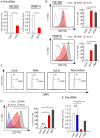Downregulation of rRNA transcription triggers cell differentiation
- PMID: 24879416
- PMCID: PMC4039485
- DOI: 10.1371/journal.pone.0098586
Downregulation of rRNA transcription triggers cell differentiation
Abstract
Responding to various stimuli is indispensable for the maintenance of homeostasis. The downregulation of ribosomal RNA (rRNA) transcription is one of the mechanisms involved in the response to stimuli by various cellular processes, such as cell cycle arrest and apoptosis. Cell differentiation is caused by intra- and extracellular stimuli and is associated with the downregulation of rRNA transcription as well as reduced cell growth. The downregulation of rRNA transcription during differentiation is considered to contribute to reduced cell growth. However, the downregulation of rRNA transcription can induce various cellular processes; therefore, it may positively regulate cell differentiation. To test this possibility, we specifically downregulated rRNA transcription using actinomycin D or a siRNA for Pol I-specific transcription factor IA (TIF-IA) in HL-60 and THP-1 cells, both of which have differentiation potential. The inhibition of rRNA transcription induced cell differentiation in both cell lines, which was demonstrated by the expression of the common differentiation marker CD11b. Furthermore, TIF-IA knockdown in an ex vivo culture of mouse hematopoietic stem cells increased the percentage of myeloid cells and reduced the percentage of immature cells. We also evaluated whether differentiation was induced via the inhibition of cell cycle progression because rRNA transcription is tightly coupled to cell growth. We found that cell cycle arrest without affecting rRNA transcription did not induce differentiation. To the best of our knowledge, our results demonstrate the first time that the downregulation of rRNA levels could be a trigger for the induction of differentiation in mammalian cells. Furthermore, this phenomenon was not simply a reflection of cell cycle arrest. Our results provide a novel insight into the relationship between rRNA transcription and cell differentiation.
Conflict of interest statement
Figures




Similar articles
-
Phosphorylation by casein kinase 2 facilitates rRNA gene transcription by promoting dissociation of TIF-IA from elongating RNA polymerase I.Mol Cell Biol. 2008 Aug;28(16):4988-98. doi: 10.1128/MCB.00492-08. Epub 2008 Jun 16. Mol Cell Biol. 2008. PMID: 18559419 Free PMC article.
-
The association of TIF-IA and polymerase I mediates promoter recruitment and regulation of ribosomal RNA transcription in Acanthamoeba castellanii.Gene Expr. 2005;12(4-6):259-71. doi: 10.3727/000000005783991972. Gene Expr. 2005. PMID: 16358415 Free PMC article.
-
Multiple interactions between RNA polymerase I, TIF-IA and TAF(I) subunits regulate preinitiation complex assembly at the ribosomal gene promoter.EMBO Rep. 2002 Nov;3(11):1082-7. doi: 10.1093/embo-reports/kvf212. Epub 2002 Oct 22. EMBO Rep. 2002. PMID: 12393749 Free PMC article.
-
Cellular stress and nucleolar function.Cell Cycle. 2005 Aug;4(8):1036-8. doi: 10.4161/cc.4.8.1925. Epub 2005 Aug 20. Cell Cycle. 2005. PMID: 16205120 Review.
-
Regulation of RNA Polymerase I Transcription in Development, Disease, and Aging.Annu Rev Biochem. 2018 Jun 20;87:51-73. doi: 10.1146/annurev-biochem-062917-012612. Epub 2018 Mar 28. Annu Rev Biochem. 2018. PMID: 29589958 Review.
Cited by
-
Targeting the RNA Polymerase I Transcription for Cancer Therapy Comes of Age.Cells. 2020 Jan 21;9(2):266. doi: 10.3390/cells9020266. Cells. 2020. PMID: 31973211 Free PMC article. Review.
-
Transcription factor regulation of ribosomal RNA in hematopoiesis.Curr Opin Hematol. 2024 Jul 1;31(4):199-206. doi: 10.1097/MOH.0000000000000816. Epub 2024 Apr 11. Curr Opin Hematol. 2024. PMID: 38568093 Free PMC article. Review.
-
Cellular differences in protein synthesis regulate tissue homeostasis.Cell. 2014 Oct 9;159(2):242-51. doi: 10.1016/j.cell.2014.09.016. Cell. 2014. PMID: 25303523 Free PMC article. Review.
-
Ribosomes: An Exciting Avenue in Stem Cell Research.Stem Cells Int. 2020 Jul 6;2020:8863539. doi: 10.1155/2020/8863539. eCollection 2020. Stem Cells Int. 2020. PMID: 32695182 Free PMC article. Review.
-
Genes affecting the extension of chronological lifespan in Schizosaccharomyces pombe (fission yeast).Mol Microbiol. 2021 Apr;115(4):623-642. doi: 10.1111/mmi.14627. Epub 2020 Nov 3. Mol Microbiol. 2021. PMID: 33064911 Free PMC article. Review.
References
-
- Boisvert FM, van Koningsbruggen S, Navascues J, Lamond AI (2007) The multifunctional nucleolus. Nat Rev Mol Cell Biol 8: 574–585. - PubMed
-
- Lempiainen H, Shore D (2009) Growth control and ribosome biogenesis. Curr Opin Cell Biol 21: 855–863. - PubMed
-
- Grummt I (2003) Life on a planet of its own: regulation of RNA polymerase I transcription in the nucleolus. Genes Dev 17: 1691–1702. - PubMed
-
- Grummt I (2013) The nucleolus-guardian of cellular homeostasis and genome integrity. Chromosoma. - PubMed
Publication types
MeSH terms
Substances
LinkOut - more resources
Full Text Sources
Other Literature Sources
Research Materials

